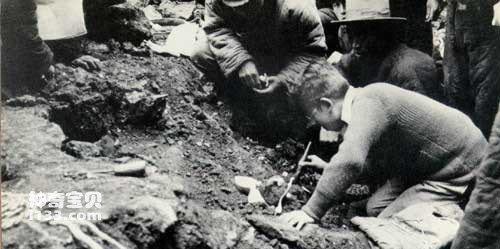Although Anderson noticed as early as 1921 that there were some white bladed vein quartz fragments at the site where the Peking Man fossils were later unearthed (later known as the "First Site"), although, since 1927, the first site has been Such stone flakes were often found after large-scale excavations at the site. However, people did not pay enough attention to them because at that time, people's knowledge about stone tools was still very limited.
After the discovery of the first complete skull of Peking Man, stone tools attracted people's attention again. At the place where the skull that shocked the world was unearthed, Pei Wenzhong discovered a quartz block with traces of artificial blows.
At the beginning of the excavation work in 1931, when loose accumulations on the ground were cleared in preparation for systematic excavation, a layer rich in quartz fragments and fragments was discovered. In July, while excavating another site called "Pigeon Hall", another enriched layer of crushed quartz was discovered.

Jia Lanpo excavated in Zhoukoudian
This year, Mr. Jia Lanpo joined the excavation team of Zhoukoudian. He was very interested in these quartz fragments and humbly learned the excavation techniques from the technicians. His open-mindedness and studiousness not only enabled him to quickly master the excavation technology, but also continuously improved his research business capabilities and organizational management capabilities; coupled with his diligence and wisdom, he transformed from an ordinary staff member who did not even have a formal university education. He gradually grew into one of the most famous prehistoric archaeologists in China and even the world - in the 1980s, he became an academician of the Chinese Academy of Sciences; in the 1990s, he was hired as a foreign academician by the American Academy of Sciences. It's a miracle.
After careful research by Pei Wenzhong, Jia Lanpo and many Chinese and foreign scholars, it has been confirmed that these quartz are indeed stone tools - tools used by Beijingers to conquer nature hundreds of thousands of years ago.
Most of Zhoukoudian's stone tools are small stone flakes. The raw materials are mainly river pebbles composed of vein quartz, sandstone, quartzite, flint and even crystals that can sometimes be found on granite hillsides several kilometers away.
People in Beijing use gravel as a hammer, use different methods according to different raw materials to break stone pieces, and then use a gravel hammer to repair them. Sometimes they also used sticks made of wood or animal horns for repairs. The repair method is mainly based on one side, and most of them are made from the split side to the back.

A scraper made by Peking Man
There are many types of stone tools of Beijing people, and different types of stone tools have different functions. They used oval river pebbles to make cutting edges from one or both sides to make machetes, which were used to cut wood and make hunting sticks; they used stone chips of different sizes to repair and make them into various shapes (including discs). shape, straight blade, convex blade, concave blade and multi-edged blade, etc.). Among them, the large concave blade scraper is used to scrape hunting sticks, and the small scraper is used as a knife in daily life. Among the Beijing people's stone tools, the pointed ones are the most sophisticated. Although they are only as big as a finger, the production procedures and methods are quite fixed, showing a certain level of technology. The pointed instrument can be used to cut and skinn animal hides, to dig tendons from bones, and to dig out worms embedded in tree trunks.
Stone hammers and anvils are tools for making stone tools, and their functions are just like hammers and anvils used for blacksmithing. The traces left on the stone hammer show that Beijingers are good at using their right hands to operate, which means that they are already "right-handed", indicating that their brains have developed a left-right imbalance similar to that of modern humans.
These stone tools of various sizes and shapes show that our ancestors, the Beijingers, have evolved to a very intelligent stage and have mastered quite skilled stone tool making technology. Because of this, they can continue to withstand the various tests of nature, and eventually develop step by step into an important part of today's human family - the yellow race (or Mongol race) including us Chinese. ).
animal tags:
We created this article in conjunction with AI technology, then made sure it was fact-checked and edited by a Animals Top editor.